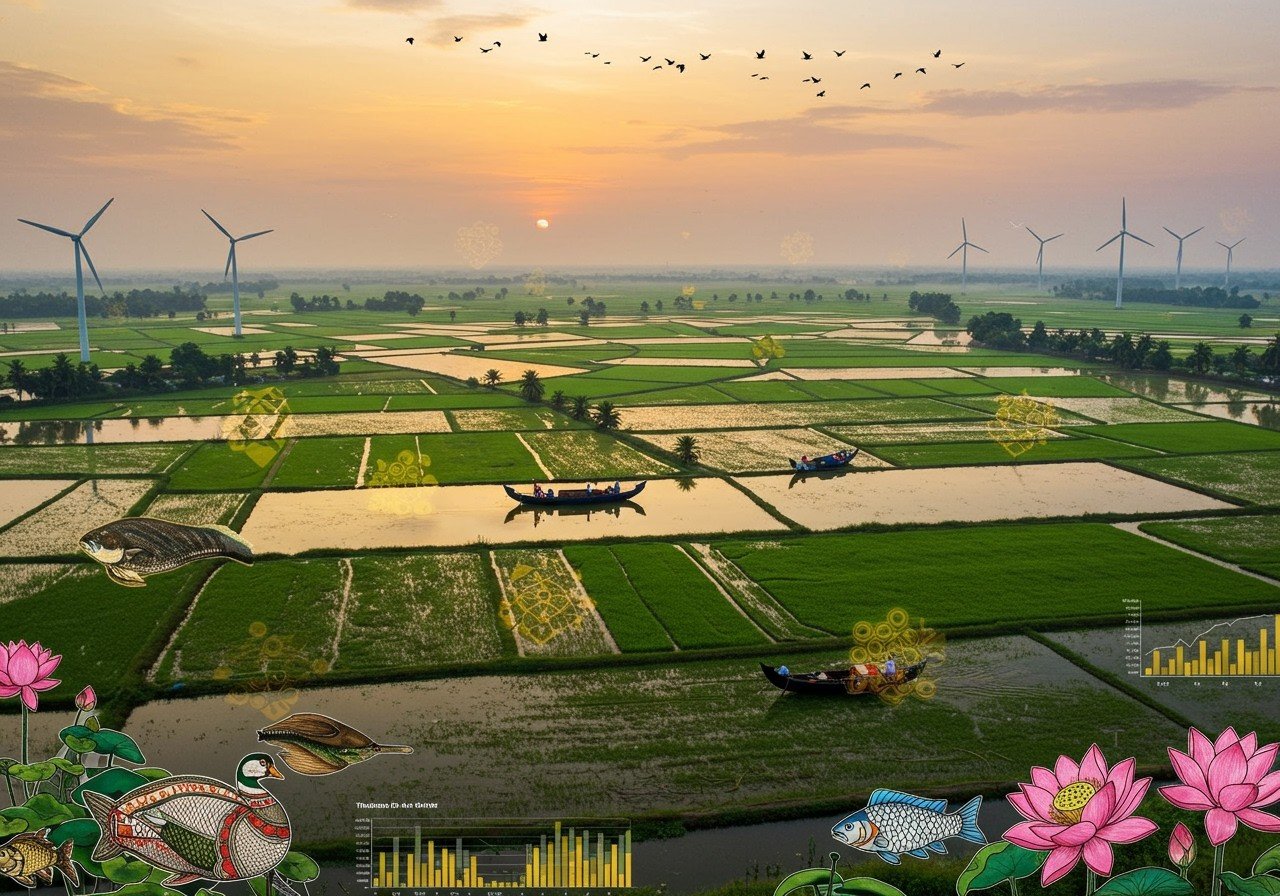
The Thrissur Kole Wetlands in Kerala, India, are a unique and precious ecosystem. They are teeming with life, supporting a wide variety of plants and animals, and playing a crucial role in the ecological balance of the region. These wetlands are not just a beautiful sight; they are vital for water management and hold deep cultural significance for the local communities. However, like many natural treasures, they face challenges from urbanization and the changing climate. Protecting these wetlands is essential to maintain their ecological functions and preserve the cultural heritage they represent.
The Ecological Importance of Thrissur Kole Wetlands
The Thrissur Kole Wetlands are a haven for biodiversity. They are home to a rich variety of migratory birds, a thriving fish population, and diverse plant life. These wetlands act like a natural sponge, storing water and nourishing agricultural lands during dry periods. They are particularly vital as habitats for endangered and endemic species, contributing significantly to biodiversity conservation. Furthermore, the wetlands play a role in carbon sequestration, helping to mitigate the impacts of climate change.
- Habitat for diverse species: The wetlands provide shelter and sustenance to a wide array of plants and animals. You’ll find everything from vibrant aquatic plants to endangered birds like the Indian Darter and the stately Purple Heron. This rich tapestry of life underscores the ecological importance of these wetlands.
- Rich biodiversity: Beyond the birds, the Kole Wetlands support a fascinating variety of other creatures. Fish, reptiles, and amphibians all find a home here, contributing to the overall ecological richness. The wetlands are a buzzing hub of life, playing an essential role in the region’s biodiversity.
Cultural and Economic Significance of Thrissur Kole Wetlands
The Thrissur Kole Wetlands are deeply intertwined with the cultural fabric of the local communities. They are the backdrop for traditional practices passed down through generations. Rice paddy cultivation flourishes here, providing a staple food and a vital source of income. The wetlands function as a natural irrigation system, ensuring crops receive water even during dry spells.
Fishing, too, is an age-old tradition intimately connected to the wetlands. Local fishermen depend on this ecosystem for their livelihood. The waters are rich with diverse fish species, providing both sustenance and economic opportunities. Traditional fishing methods are still practiced, demonstrating a harmonious relationship between the people and the natural world.
Moreover, the wetlands offer promising prospects for eco-tourism. Visitors can immerse themselves in the rich biodiversity, experience the local culture, and contribute to conservation efforts. Eco-tourism can boost the local economy while raising awareness about the importance of preserving these precious ecosystems. Learn more about the cultural significance of nearby Vadakkumnathan Temple here.
Thrissur Kole Wetlands in 2025: Challenges and Opportunities
Looking ahead to 2025 and beyond, the Thrissur Kole Wetlands face significant challenges. Rapid urbanization poses a constant threat to the health and biodiversity of this delicate ecosystem. Expanding cities can lead to habitat loss and pollution, disrupting the intricate balance of the wetlands. Climate change adds another layer of complexity. Altered rainfall patterns and rising temperatures can disrupt the natural cycles of the wetlands, impacting water availability and biodiversity. This underscores the need for proactive measures to protect this valuable ecosystem.
- Important Bird Area: Recognized by BirdLife International as an Important Bird Area, the Thrissur Kole Wetlands are a crucial stop on the Central Asian Flyway. They offer refuge to over 250 bird species, including endangered species like the greater spotted eagle. This makes the wetlands essential not just locally, but internationally.
- Key Biodiversity Area: The Kole Wetlands have earned the designation of a Key Biodiversity Area of international significance. This recognition highlights the crucial role they play in global biodiversity conservation. The wetlands meet stringent criteria for identifying sites of significant biodiversity importance, solidifying their status as a global treasure.
Sustainable development practices are crucial in this context. Policy interventions must prioritize the preservation of the wetlands while accommodating growth. Protecting this ecosystem ensures its ecological and cultural roles remain intact for future generations.
A Comparative Study: Ponnani Kole Wetlands
Comparing the Thrissur Kole Wetlands with the Ponnani Kole Wetlands reveals both similarities and differences in the conservation challenges they face. Both wetlands boast rich biodiversity and are threatened by urbanization and climate change.
Learning from the conservation efforts in Ponnani can inform and improve initiatives in Thrissur. Sharing knowledge and collaborating on solutions are essential for effective wetland preservation throughout the region.
- Fish diversity: Studies have revealed a remarkable diversity of fish species within the Kole Wetlands, particularly in areas like the Pullazhi Kole Wetlands. Researchers have identified 25 fish species from 8 orders and 14 families, indicating a thriving aquatic ecosystem.
- Supports agriculture: The Kole Wetlands play a vital role in supporting local agriculture, especially paddy cultivation. They serve as a natural irrigation system, ensuring a consistent water supply for crops. They also act as a natural flood control mechanism, protecting valuable farmland from inundation.
Wetland Conservation in India
Across India, there is growing momentum in wetland conservation efforts. The Ramsar Convention plays a pivotal role in shaping national strategies, providing guidelines for identifying and protecting vital ecosystems like the Thrissur Kole Wetlands. Community-driven initiatives are also making a significant impact. Involving local populations fosters a sense of ownership and strengthens the commitment to conservation. Combining traditional knowledge with scientific research can lead to innovative and effective solutions. Successful projects across India demonstrate the power of collective action. Preserving wetlands isn’t just about environmental protection; it’s about safeguarding our cultural heritage and ensuring sustainable livelihoods. Discover more about Thrissur’s hidden gems and local experiences.
How Poojn Supports Thrissur’s Wetland Heritage
At Poojn, we deeply appreciate the profound connection between spiritual practices and environmental preservation. We recognize the Thrissur Kole Wetlands as a place of both natural wealth and cultural significance. We offer eco-friendly puja items that align with these values. Poojn.in is committed to providing authentic and sustainable products for your spiritual needs.
Our specially crafted Latai, made from sustainable materials, helps you maintain harmony between your religious practices and environmental responsibility. This traditional item is ideal for your puja ceremonies, supporting responsible sourcing that helps protect wetland ecosystems like those in Thrissur.
You can also explore our range of Kakkal , Kalwa Raksha Sutra, Ashtagandha Kumkum and other puja essentials at Poojn.in.
Key Features of Our Eco-Friendly Latai:
- Crafted from sustainable materials, minimizing environmental impact.
- Made with traditional craftsmanship, reflecting authentic artistry and cultural heritage.
- Suitable for both daily puja and special ceremonies, adding a touch of sacredness to your rituals.
- An environmentally conscious choice, allowing you to express your spirituality while caring for nature.
To order your eco-friendly Latai or to discover more about our sustainable puja samagri:
- Call us at: 03369029784
- WhatsApp us at: 9476142738
- Visit our website: www.poojn.in
Make your puja more meaningful with products that honor both tradition and nature. Shop at Poojn – India’s Biggest Dashakarma Bhandar, where spiritual values and environmental responsibility come together.
Conclusion
The Thrissur Kole Wetlands stand as a testament to India’s rich cultural heritage and vibrant biodiversity. As we move towards the future, preserving these wetlands becomes even more critical. They are not merely a natural habitat; they are a lifeline for local communities, supporting traditional farming and fishing practices that have sustained generations. In the face of challenges like urbanization and climate change, adopting sustainable development practices is paramount. By learning from other conservation efforts and actively involving local communities, we can protect these invaluable ecosystems. The Ramsar Convention and various community-driven initiatives provide a roadmap for effective conservation strategies. By recognizing and valuing the ecological and cultural roles of the Thrissur Kole Wetlands, we ensure they remain a cherished part of our heritage for generations to come. By embracing eco-tourism and sustainable livelihoods, we can create a harmonious balance between progress and preservation. Let’s work together to safeguard these wetlands, honoring their past while securing their future.
FAQs on Thrissur Kole Wetlands
What are the Thrissur Kole Wetlands? The Thrissur Kole Wetlands are a unique and vital wetland ecosystem located in the Thrissur district of Kerala, India, known for their rich biodiversity and crucial role in supporting local communities. Learn more about Hindu philosophy here.
Why are the Thrissur Kole Wetlands important for biodiversity? The Thrissur Kole Wetlands are a haven for a wide variety of plant and animal life, including numerous bird species, fish, and unique flora. This biodiversity is essential for maintaining the ecological balance of the region. Explore more on Hindu symbols.
How do the Thrissur Kole Wetlands contribute to the local climate? These wetlands play a vital role in regulating the local climate by influencing humidity and temperature. They also contribute to groundwater recharge and act as a natural flood control system.
What is the significance of the Kole Wetlands in 2025 and beyond? As we look towards the future, the Kole Wetlands become even more significant. They continue to support agriculture, provide livelihoods, and are crucial for maintaining biodiversity, especially in the face of climate change and increasing urbanization.
What makes the Thrissur Kole Wetlands different from other wetlands like the Ponnani Kole Wetlands? While both are part of the larger Kole Wetlands system in Kerala, they have unique characteristics. The Thrissur Kole Wetlands are particularly important for supporting diverse bird populations, while the Ponnani Kole Wetlands are known more for rice cultivation and fish diversity.
What are the main challenges facing the Thrissur Kole Wetlands? These precious wetlands face several threats, primarily from urbanization, pollution, and the impacts of climate change. Conservation efforts are vital to protect this ecosystem from further degradation.
Why is wetland conservation important in India? Wetland conservation in India is essential for preserving biodiversity, supporting agricultural practices, and mitigating natural disasters like floods and droughts. Wetlands like the Thrissur Kole Wetlands play an irreplaceable role in maintaining the ecological balance of our country. Check our Brass Tortoise & Brass Doob Grass collection.
What steps are being taken for the conservation of Thrissur Kole Wetlands? Various initiatives are underway for the conservation of these wetlands, including government programs, local community involvement, and awareness campaigns to protect and restore the natural habitat. The focus is on integrating sustainable practices and preserving the ecological and cultural significance of this precious ecosystem.


